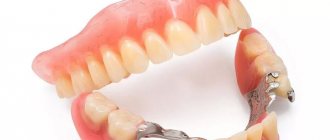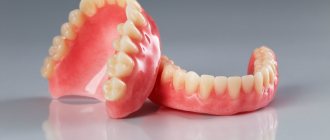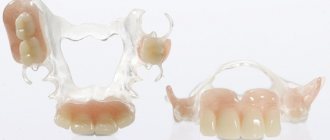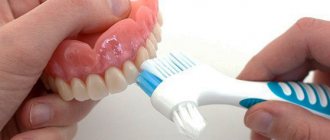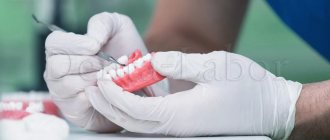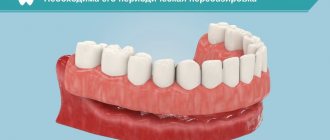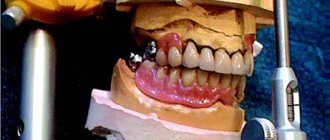Clasp dental prosthesis in Elident dentistry at the best price in Moscow. A detailed description of the pros and cons of clasp dentures, as well as their types and prices.
Despite the fact that dental implantation is one of the most relevant and popular methods of restoring lost teeth, not every patient can afford this type of treatment. This is due to the presence of certain contraindications or financial reasons. Fortunately, modern dentistry does not stand still, and today it is possible to reproduce missing dental units using clasp prosthetics.
The obvious advantages of a clasp prosthesis include the presence of a durable design and the use of high-quality materials in its manufacture. Moreover, it occupies only a small space in the oral cavity, does not create obstacles during communication and chewing food, is easy to maintain, is famous for its aesthetic appeal and has a long service life. However, clasp dentures can only be used if there is a partial deficiency of natural units.
We will talk about these and other features of the clasp in this article.
Free consultation
Our specialists will conduct a free consultation and select the best treatment option for you.
Sign up now! Online registration
+7 (495) 649-41-19
Content
1 Removable clasp dental prosthesis: what is it?
2 In what cases is this prosthetic option preferable?
3 Photos before and after installation of the clasp prosthesis
4 Types of clasp dentures
5 Characteristics of clasp dentures?
6 Clasp prosthesis with locks
7 Designs using telescopic crowns
8 Prices for clasp dentures 8.1 Cost of clasp dentures with clasp fastenings
8.2 How much does a clasp prosthesis with locking retainers cost in Moscow?
9 Reviews about prosthetics with clasp structures
10 Caring for clasp dentures
11 Are there alternatives to clasp dentures?
Service life and care rules
The minimum service life of a telescopic prosthesis is 3 years. With proper care, the structure can last longer - up to 10 years. Like all dentures, over time they become less secure and require correction. To maximize the life of the structure, it is recommended to regularly visit the dentist and properly care for the prosthesis.
Telescopic dentures are designed to be worn around the clock - there is no need to put them in water before going to bed. The structure will only need to be removed for hygienic cleaning. Care activities include:
- cleaning dentures after eating (it is advisable to use special brushes for dentures with long bristles and a wide head;
- use of tablets to clean dentures (in consultation with the dentist);
- prof. examinations by a doctor to check the condition of the prosthesis.
To avoid damaging the structure during home cleaning, it is best to remove and put on the prosthesis in front of a mirror over a soft surface or over a sink with water or a towel (if the prosthesis slips out of your hands, it will not be damaged).
Removable clasp dental prosthesis: what is it?
Clasp structures are often used in modern orthopedic practice. They allow you to recreate lost units in the upper and lower jaw. If you examine the clasp removable denture up close, you will notice the presence of an arched base made of plastic or metal material. In addition, this orthopedic product includes crowns attached to the base and special fixation elements.
In what cases is this prosthetic option preferable?
The main conditions under which a clasp prosthesis for the lower jaw is a priority method of treatment include: the inability to use implants and the presence in the oral cavity of at least several healthy natural crowns acting as supports.
As is known, partial construction can be used both to recreate one lost unit and to reproduce several missing teeth. In addition, a clasp denture fixed to the upper jaw provides the possibility of complete restoration of the dentition.
Also, a splinting clasp prosthesis, which has a supporting function, is relevant. It is indispensable when replacing missing parts in a row, serves as an internal support for native crowns affected by periodontal disease, prevents the complete loss of native crowns, and helps preserve the functionality of damaged teeth.
How are dentures made?
The telescopic crown of the tooth and the frame of the structure are made of palladium, gold, and cobalt-chromium alloys - ideally, both parts of the system should be made of the same material. The use of precious metals increases the cost of the product, but it ensures higher strength and also eliminates the risk of allergic reactions.
On a note! The latest word in dentistry is the use of galvanic technology. The structures are made from an alloy of base metals or zirconium dioxide, and gold is applied to the outside. The surface is covered with composites.
If telescopic crowns are recommended, the fabrication and installation steps may take more than a month in total. The process includes:
- history taking and examination: the doctor finds out the condition of the patient’s teeth, bite characteristics, allergic status and other nuances. The most important stage is the selection of supporting elements. The dentist will have to assess whether they can withstand the load. Errors in selection are fraught with loosening of elements and their further loss,
- production of the structure: first, impressions are taken from each jaw, from which dental technicians make a model. Then the blank is tried on in the patient’s mouth and adjustments are made. Next, the workpiece is again sent to the laboratory, where it is brought to perfection,
- preparation of supporting elements: if necessary, they are treated. Then the orthopedist grinds down the teeth and installs permanent crowns. After this, the telescopic crowns of the removable part are fixed.
Don't know what type of prosthetics to choose?
We will help in the selection, advise where to read more information and compare types of prosthetics.
Consultation with an orthopedic doctor in Moscow clinics is free! Call now or request a call
Working hours: from 9:00 to 21:00 - seven days a week
The production of such products is a complex and labor-intensive task, requiring highly qualified specialists. Even small deviations from technology can lead to negative consequences. In addition, the system is quite expensive, so the patient expects to receive a truly high-quality product that will be a worthy alternative to removable dentures.
It usually takes no more than 3 days to make an internal crown. The removable part requires a longer period - up to 4 weeks. How long it will take to prepare the abutment teeth depends on their condition.
Characteristics of clasp dentures?
The most simplified option is a clasp prosthesis with clasps . However, despite the simplicity of this design, it perfectly reproduces the chewing characteristics of missing units, compared to removable counterparts made of nylon or plastic. A distinctive feature of this product is the use of clasps that act as holding supports.
Properties of clasps:
- Ability to transfer chewing load to supporting units;
- Prevents the risk of the arched structure shifting.
As a rule, such fastening elements are made of metal material. But to improve the aesthetic characteristics of the clasps located on the front side of the teeth, they can be made of nylon.
Advantages of products with clasp fastening
- Provides the ability to chew food efficiently. This eliminates any discomfort inherent in nylon prostheses;
- Promotes reliable fixation of the structure;
- A simple production method, which has a positive effect on the price indicators of clasps;
- The base of such products has a compact size, which eliminates the loss of taste, prevents changes in diction and greatly facilitates the process of wearing.
What are the “disadvantages” of a clasp denture fixed to the lower jaw?
When considering clasp removable dentures with a similar fixation mechanism, as well as their pros and cons, it is impossible to ignore the following points:
- Insufficient aesthetic parameters . In some situations, such metal fasteners are fixed only on the outer side of natural crowns and end up in the frontal zone, which is accompanied by a violation;
- Risk of destruction of units acting as supports . Due to micromobility, which is a necessary condition when installing and removing a product from the oral cavity, metal clasps can have a negative effect on the enamel;
- Inflated prices . Prices for clasp dentures in Moscow are considered higher than their classic acrylic counterparts. This is due to a more labor-intensive production process and improved operating and chewing comfort.
Types of prostheses
There are several types of prostheses, which differ in their design components. Each type of product has its own advantages and disadvantages.
- Clasp prosthesis
The design can have a variety of shapes that correspond to the defect in the dentition. A metal arch connects the base of artificial crowns and fixing elements. The latter are often played by clasps - metal hooks. This clasp is reliable, fully restores function, does not cause complications, and has a long service life. The downside is the lack of aesthetics - in the smile area, the hooks can be noticeable.
- Acrylic prosthesis
The product has a base made of acrylic plastic. The advantages of the design include affordable cost, good strength, simple manufacturing and maintenance processes. The disadvantage of plastic is the rigidity of the material, which you need to get used to, as well as the risk of developing allergies.
- Acree Free prosthesis
A modern clasp made from a new material is called Acree frie. The material does not contain acrylic, therefore it is more biocompatible and hypoallergenic. This base is quite durable, aesthetic and comfortable.
- Nylon dentures
The products are distinguished by the manufacture of a base made of nylon - a soft, elastic, elastic material. Comfortable to use, easy to put on and take off, and look beautiful. Their disadvantage is the need for special cleaning; their service life is only 3-5 years.
Clasp prosthesis with locks
In addition to the above type of fastening, there is the possibility of fixing clasp products, which involves the use of special locking clamps. In this case, one part of the micro-lock is located on the structure, and the other is on the supporting crowns. After “putting on” the clasp, the lock snaps into place, which contributes to its secure fixation.
As for the type of such fastenings, in modern dentistry micro-locks “Bredent” and “MK-1” are most often used. Despite the inflated cost of these fixation systems, they are among the best, as they are famous for their high degree of reliability and long service life.
Among the advantages of a clasp prosthesis with locks , the following are of particular importance:
- High reliability of prosthesis fastening;
- Impeccable aesthetic parameters;
- Comfort while chewing food;
- No pain when wearing;
- Long operational period - up to 7-8 years.
Despite all the advantages of such a system, a clasp denture for the upper jaw with locks has some “disadvantages”. These include:
- Somewhat overpriced;
- It is necessary to use a large number of support units (at least 4);
Labor intensity of the production process. The manufacture of such high-tech products should be carried out by specialists of the highest category.
Advantages and disadvantages of telescopic prostheses
Bridges on telescopic crowns have the following advantages:
- securely fastened (the bridge is placed directly on the crowns and is fixed better than with clasps);
- have a solid design (there are no moving elements that could break);
- do not affect pronunciation;
- do not cause a gag reflex (there is no pressure on the root of the tongue);
- does not cause dry mouth (the salivary ducts remain open);
- look aesthetically pleasing and invisible to others;
- amenable to restoration after tooth loss;
- have a good effect on the periodontium (teeth under telescopic crowns are also involved during chewing);
- can be installed in patients with pathological mobility of teeth (practice shows that once they start wearing a prosthesis, problematic teeth stop loosening);
- do not affect taste buds (since the palatal and sublingual space remains free, nothing interferes with enjoying the taste of food).
There are also disadvantages:
- the need to correct all supporting teeth;
- technologically complex manufacturing process, eliminating the slightest errors;
- impossibility of installation on teeth with short clinical crowns, teeth in an inclined position, with tooth wear of II-III degree.
The result of telescopic prosthetics primarily depends on the work of the orthopedist and dental technician. You can find an experienced dentist using the search system of our portal.
Constructions using telescopic crowns
This option of prosthetics is considered quite popular in Western countries, but the above-mentioned clasp dentures are not popular in Moscow and other cities of the Russian Federation. The essence of the technique is as follows: initially, the supporting units are prepared, then metal caps are placed on them. A special cement composition is used to fix the orthopedic product.
As a rule, the above metal caps serve as supports for crowns located on the clasp and connected to the metal base of the structure. This fastening method promotes strong fixation of the prosthesis, allows for optimal distribution of the chewing load, provides the necessary aesthetic effect and has more reasonable prices compared to products with clasps.
Indications for installation
Splinting clasp prosthetics is used in the following situations:
- Loss of 3-5 adjacent teeth if there is no reliable support on either side.
- Gum pathologies accompanied by frequent bleeding.
- Loss of a tooth and loosening of several of its neighbors.
- Bruxism, abnormal deep bite.
- Formation of voluminous gum pockets, exposure of tooth roots.
- Periodontal diseases.
If teeth are loose and periodontal tissue is damaged, splinting should be done as soon as possible. If this is not done, the radical units will begin to fall out. Under the influence of high chewing load, the teeth will begin to tilt in different directions and change their original position. Clasp splinting prosthetics allows you to avoid all these consequences.
Prices for clasp dentures
If you need to install a clasp prosthesis, its price will be determined, first of all, taking into account the type of fastening used. If you are interested in prosthetics using micro-locks, then to the total amount you need to add the cost of the above fixation elements, as well as the price of crowns made of metal-ceramic material.
If a patient is fitted with a clasp prosthesis , its price will be calculated depending on the labor intensity of the production process. That is why such clasps are divided into complex and simple. In the first case, the design provides for a more complex clasp mechanism.
| Service | Price, ₽. |
| Consultation with an orthopedist | for free |
| Clasp prosthesis on fireproof | 35 000 |
| Clasp prosthesis on fireproof with Bredent lock | 42 000 |
| Clasp prosthesis on fire-resistant interlocks | 42 000 |
| Clasp prosthesis on fireproof with MK lock, MK-I double-sided | 65 000 |
Cost of clasp dentures with clasp fastenings
Next, we will tell you how much a clasp prosthesis costs in budget and medium-level institutions. For example, a simplified clasp prosthesis for the lower jaw has a price of up to 40 thousand rubles. In the regions, such a structure can be installed for only 20 thousand rubles. For a complex clasp you will have to pay approximately 45 thousand rubles. The most expensive is the splinting clasp prosthesis; its cost can reach 55 thousand rubles.
How much does a clasp prosthesis with locking clamps cost in Moscow?
The cost of a clasp with the Bredent fastening system can reach 90 thousand rubles and more. In this case, the final amount includes: the price of the product itself, the cost of locking mechanisms and four metal-ceramic crowns. However, the MK-1 fixation elements are considered more convenient, durable and wear-resistant, the price of which is 15 thousand rubles higher than the cost of the first version of the fixators.
At the Elident clinic, a fireproof clasp with a Bredent locking mechanism costs about 42 thousand rubles. In turn, a design with an MK or MK-I fastening system will cost 65 thousand rubles.
If there is a defect at one end, when there are restrictions for implantation, it is advisable to use a one-sided clasp prosthesis, for which you will have to pay at least 40-50 thousand rubles.
Our clinics
Clinic "Elident" on Varshavskaya
Varshavskoe highway, 75, bldg. 1, Moscow 117556
- Varshavskaya (500 m, closed until 2021)
- Nakhimovsky Prospekt (1,300 m)
Mon-Sat : 09:00-21:00; Sun : 09:00-19:00.
Online registration
+7 (495) 649-41-19
Elident Clinic in Annino
Varshavskoe highway, 154, building 1, Moscow 117405
- Annino (500 m)
- Academician Yangelya (700 m)
Mon-Sat : 09:00-21:00; Sun : 09:00-19:00.
Online registration
+7 (495) 649-41-19
Reviews about prosthetics with clasp structures
If you are interested in the question of which structures are best to install, clasp dentures have already earned the most positive reviews. This is due, first of all, to the presence of a metal base, which ensures optimal dimensions of the structure and achieves maximum comfort during its operation, as well as when communicating and chewing food.
- Convenience during wearing : when such an orthopedic product is put on the lower jaw, the necessary space remains for the movement of the tongue, reduces the likelihood of changes in diction and minimizes the risk of sudden loss of the structure from the oral cavity. This is facilitated, first of all, by the presence of a small plastic base. In the case of restoration of the upper units with a nylon or plastic analogue, the entire sky is covered with the base of the structure. If a clasp prosthesis is fixed on the upper jaw, then the frontal part of the palate, which is responsible for taste sensations and normal spoken speech, remains free;
- Long service life : the service life of the clasps can reach 5-7 years compared to their removable plastic counterparts, which require mandatory replacement every 2 years. This is due to the rapid rate of loss of bone under a conventional prosthesis, which is accompanied by discomfort during wear and weakening of fixation;
- Increased reliability indicators : the probability of the clasp breaking is quite low, since it includes a solid base made of high-strength metal.
Telescopic prosthesis fixation system
The design consists of two parts:
- Non-removable. It is a metal cap with parallel walls. Attached to an abutment tooth or an implant.
- Removable – bridge with built-in telescopic crowns. It is placed on the corrected abutment teeth, which act as strong retainers. Covers only the gums, the palatal and sublingual space remains free.
Telescopic crowns come in cylindrical or conical shapes.
- The former do not provide adhesion very well, and their use is justified only on absolutely healthy and undamaged teeth and surrounding tissues. The process of manufacturing cylindrical crowns is complex and expensive.
- The latter have low sensitivity to bridge errors and the consequences of its active use, and therefore conical telescopic crowns are used everywhere. The more pronounced the conical shape, the easier it is to secure the structure. The downside is that sticky and slippery foods can loosen the seal.
Caring for clasp dentures
The process of getting used to the clasp design takes about 2-3 days. Initially, the patient may feel slight discomfort during communication, which is quickly eliminated with the help of special exercises. You may also have difficulty chewing food. That is why experts recommend dividing food into small portions at the initial stages. It is advisable to avoid products that are too hard and sticky. To get used to the prosthesis faster, it is not recommended to remove it while sleeping at night.
In the morning and evening, the structure should be removed from the oral cavity, thoroughly cleaned using special compounds, and also placed in an antiseptic solution. To store the clasp, it is recommended to use a special container, without water.
Are there alternatives to clasp dentures?
According to many dentists, the use of a clasp denture is considered the best method for restoring missing teeth. But it is also possible to use other partial removable structures, which include:
- Acry-Free dentures;
- Acrylic products;
- Nylon analogues.
- Conditionally removable dentures, which are supported by implants.
Article expert (author):
